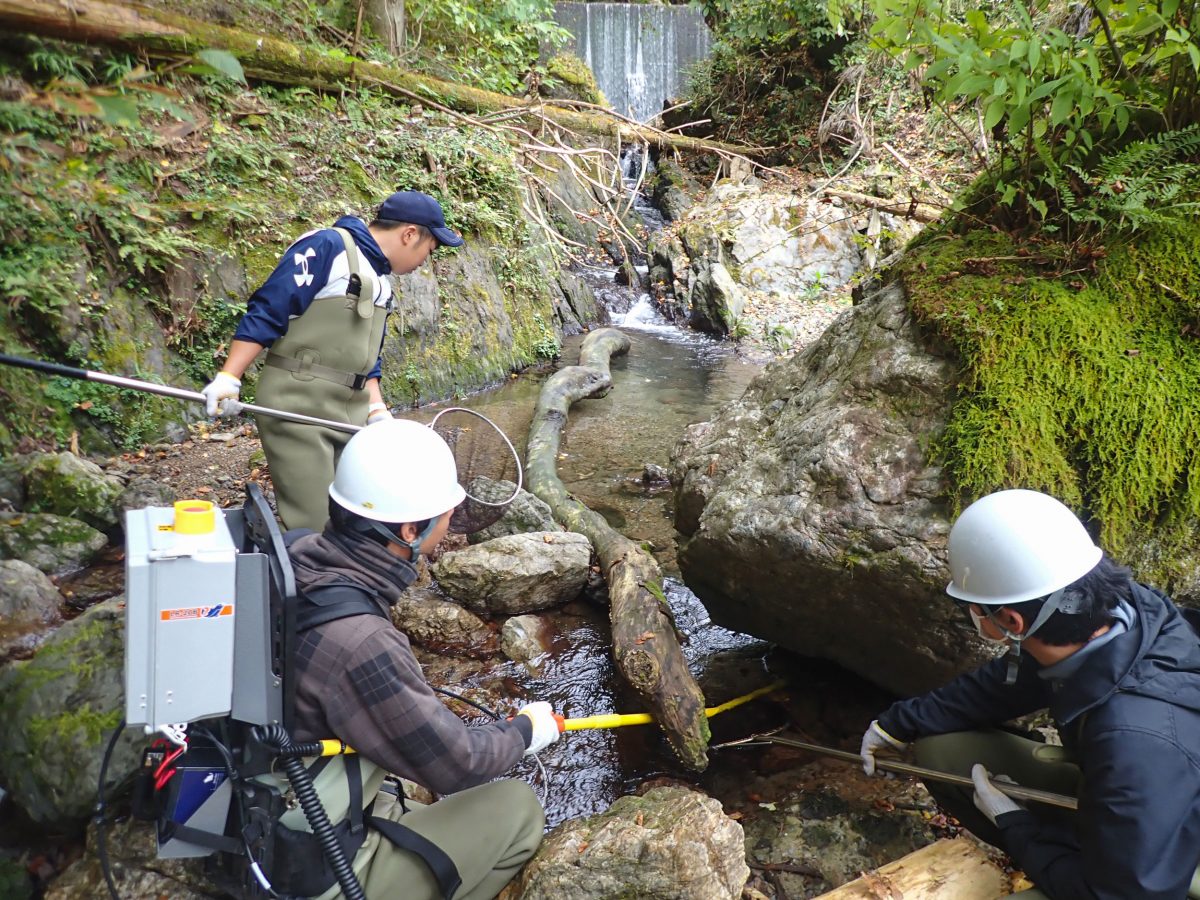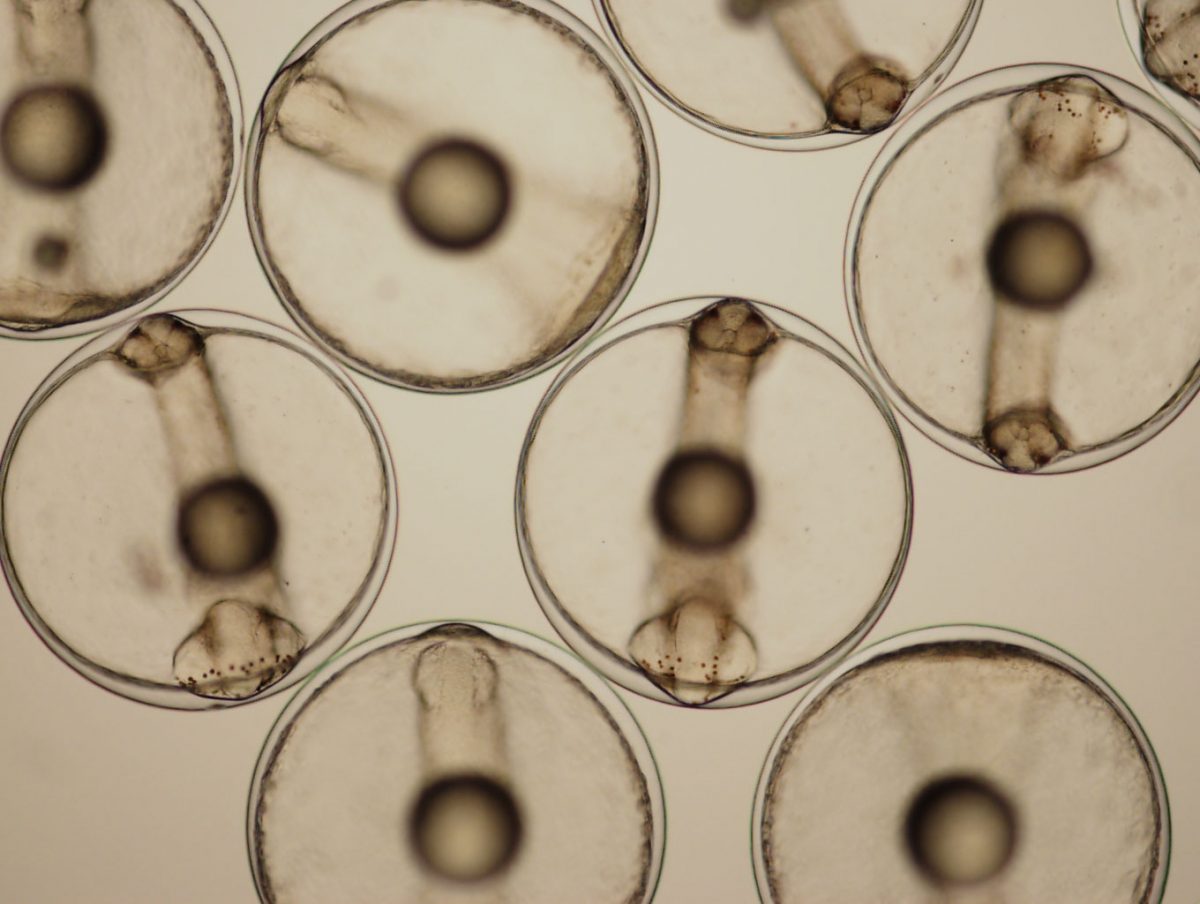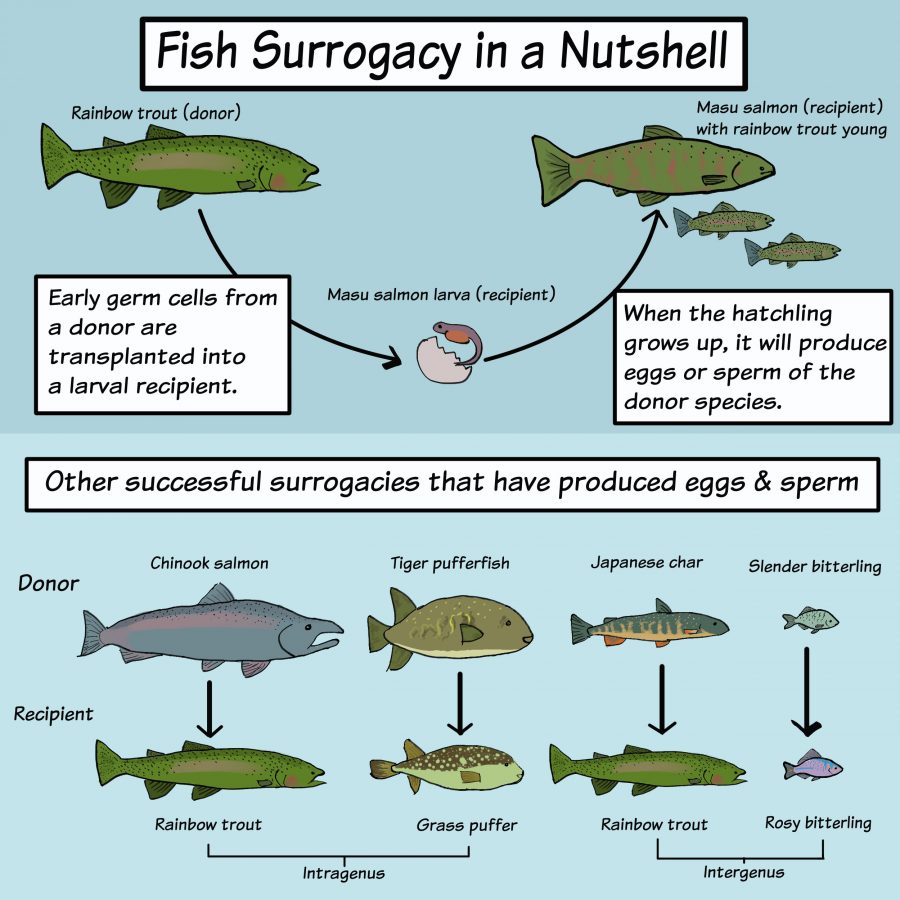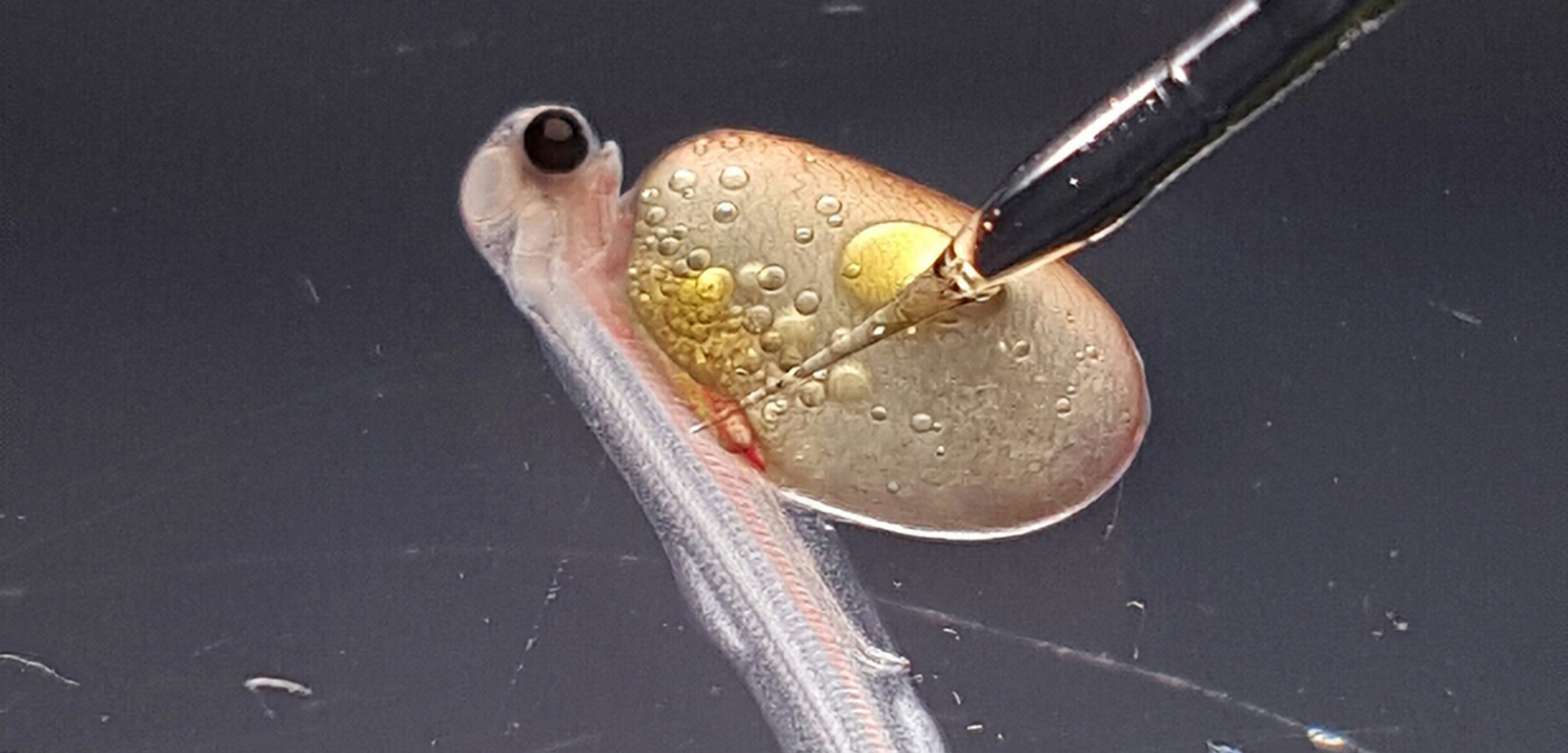Surrogacy Across Species
Scientists can now borrow the bodies of one fish species to produce another—whether they should, though, is an open question.
Article body copy
One spring morning in a lab filled with gurgling fish tanks, Goro Yoshizaki is doing his rounds, a twice-weekly ritual. The tanks, stacked neatly on shelves, are brimming with fish Yoshizaki is rearing. He peers expectantly into one that houses Chinese rosy bitterling and sees the beginnings of a transformation: the male fish, often silver, are starting to turn shades of orange and green, and some of the females have sprouted a thin, tube-like organ from their bellies. They’ll use it to lay eggs.
“That is a good sign,” Yoshizaki says brightly. He has been waiting for nearly two months for the fish to reach sexual maturity. Within weeks, he hopes, they will spawn and produce the eggs and sperm of an entirely different species.
For the past 20 years, Yoshizaki, a professor of marine biosciences at Tokyo University of Marine Science and Technology in Japan, has been developing a way to borrow the body of one species to produce the sperm and eggs of another. Just as a doctor might borrow the uterus of a surrogate mother to nurture a human embryo, Yoshizaki borrows the gonads of a surrogate fish to cultivate eggs and sperm, or milt.
Chinese rosy bitterling are one of his latest experiments. The species, invasive in Japan, outcompetes native bitterling. When the invasive bitterling spawn in Yoshizaki’s lab, they’ll produce the sperm and eggs of the Tokyo bitterling, an endangered species considered a “national monument,” a federal designation that gives it special protection. “It’s an ironic situation,” he says. The invasive bitterling will reproduce the very species they are driving to extinction in the wild.
These fish won’t be the first to produce gametes—eggs and sperm—that aren’t their own. In 2004, Yoshizaki managed to get salmon to spawn trout. He and his colleagues have since used surrogacy to successfully breed several other species, including pufferfish and Japanese yellowtail, and researchers at other institutions have been exploring its use in sturgeon, carp, and trout.

Fisheries scientists working with Goro Yoshizaki of Tokyo University sample Japanese char in the Arakawa River north of Tokyo, Japan. Photo courtesy of Goro Yoshizaki
A future that uses surrogates to aid in aquaculture or conservation could have major implications. Surrogates may allow fish farmers to breed large species in smaller bodies, cutting the cost of producing fish for human consumption. Conservation biologists could use common species to spawn endangered ones. Beyond breeding fish in unexpected ways, the cells researchers implant in surrogate parents can be cryogenically stored, which means scientists can bank the genetic information of species and use it to spawn more of those same fish in the future—an elusive goal they’ve been pursuing for decades. Surrogates could help save species. Whether scientists should use them to do that, however, is less clear.
The idea of freezing cells to save them goes back centuries, but the first major successes in cryopreservation date back to the mid-1900s. In 1949, researchers in London froze fowl semen, and after thawing, the sperm kept right on swimming. Soon after, a cow gave birth to the first calf conceived from frozen-and-thawed sperm. Researchers named it Frosty.
Cryopreservation chills cells or tissue samples to -196 °C. In these frigid conditions, all biological processes stop, and researchers can store cells for years. “They’re in suspended animation,” says Mary Hagedorn, a marine biologist at the Smithsonian Conservation Biology Institute in Washington, DC. When scientists want to bring back a desirable set of genes or boost the genetic diversity of a species at risk of inbreeding, they can thaw a particular sample and the cells’ biological activity restarts, picking up where it left off.
Although cryopreservation was initially used to store cells from humans and domesticated animals, it has since been applied to wild species. In 1975, the San Diego Zoo in California started banking cells for its Frozen Zoo, a library of cryogenically stored samples. It now holds cells and tissues from more than 1,000 species and subspecies, including cheetahs, gorillas, and African elephants. Another frozen zoo, the UK-based Frozen Ark project, stores genetic material of endangered animals from snow leopards to spider monkeys. Sperm are easy to freeze, partly because they’re so small. Cryopreserving eggs or embryos is rarer, but it’s possible for some species: humans and nearly extinct northern white rhinos, for example.
For fish, however, freezing and thawing eggs or embryos is notoriously difficult. First, they’re much bigger than sperm. While a human egg is roughly the size of a grain of sand, fish eggs are as big as a popcorn kernel, which is a problem when it comes to cryopreservation. “As the cells get larger and larger, you may start to get ice crystals forming inside,” Hagedorn says. The crystals end up destroying the cells.
Freezing fish eggs also presents a catch-22, says Ákos Horváth, professor of aquaculture at the Hungarian University of Agriculture and Life Sciences. Before freezing their samples, researchers have to remove water from them. They replace it with a mixture of chemicals that protects eggs as they’re frozen. In fish eggs, however, those chemicals activate biological processes that make them incapable of later being fertilized. Instead, some researchers have tried to freeze fish embryos, which, unlike sex cells, contain a complete set of genes from both parents, but that too has proved difficult. Ice crystals also form as embryos thaw, turning them into mush. As a result, frozen repositories for fish generally only store milt, and female genes are missing. “You only have one half of the species,” Horváth says.

A researcher from the Hungarian University of Agriculture and Life Sciences transplants rainbow trout germ cells into tiger trout larvae, which have been anesthetized and laid on their sides in a petri dish. Photo by György Hoitsy
Scientists have worked to cryopreserve the female genes of fish since the 1950s, largely without success. Over time, their ideas have grown more creative. In 2017, Hagedorn and her colleagues got zebrafish embryos to survive a deep freeze by microinjecting them with gold nanoparticles, submerging them in liquid nitrogen for two minutes, and thawing them with a laser. (The specks of gold absorbed the laser’s heat, allowing the team to defrost the embryos fast enough to avoid the dreaded ice crystals.)
Others have tried to circumvent the challenge by bypassing the need for female genes altogether. In the 1980s, researchers created embryos using the genetic material from sperm alone, by duplicating the chromosomes provided by a single father. That process can work, Horváth says, but the mortality rate is incredibly high. Only about one in 1,000 juvenile fish survives.
So far, the most promising approach for generating fish from frozen material involves surrogates like the ones in Yoshizaki’s lab. Cryopreserving fish was a mystery Yoshizaki never set out to solve. In the early 2000s, he was researching ways to create genetically modified fish for aquaculture when he discovered that he could grow the sex cells from one species in another. The finding revived in him a long-held desire to help conserve the animals. As an avid fly fisherman in college, he’d been distressed to find that the fish in his favorite streams had disappeared from one year to the next. Fish surrogacy, he thought, might provide a path to improving aquaculture—and it might also save species.
To make a surrogate, Yoshizaki collects early germ cells from the gonads of a donor fish and transplants them into another fish. There, the immature cells develop into sperm or eggs. By pairing male and female surrogates, researchers can breed new fish that match the donor species. And by combining surrogacy with cryopreservation, scientists can avoid freezing eggs or embryos. Instead, they can freeze early germ cells and thaw them before transplant. The cells’ small size and simple structure makes them easy to cryopreserve. Once, Yoshizaki and his colleagues stuck a whole trout in a deep freezer without any chemical protectants. Two years later, when the team pulled the fish from the freezer, they were surprised to discover that they could still harvest the cells they needed to produce the frozen trout’s eggs and sperm.
Although freezing the cells is almost foolproof, transplanting them is a more delicate operation. From a vial containing a donor fish’s early germ cells, Yoshizaki sucks about 10 cells into a fine glass tube and, under a microscope, injects them into the body cavity of a newly hatched larva, no bigger than a pea. The larva provides a hospitable home, since it isn’t yet capable of rejecting a donor’s cells. Repeating the process again and again, he can use the cells of a single donor fish to inject between 10 and 100 larvae.

Yoshizaki and his colleagues edited the genomes of these Nibe croaker embryos to sterilize them so that they can be used as surrogate parents. Photo courtesy of Tokyo University of Marine Science and Technology
Finding a surrogate capable of incubating a foreign species’ cells, however, is less precise. The surrogate and the donor should belong to the same genus or family—if researchers stray too far on the evolutionary tree, the cells won’t develop into eggs or sperm. Ideally, a surrogate is also sterile, so that when it reaches maturity it produces only the donor’s gametes. If the procedure is successful, the donor’s cells migrate inside the surrogate’s body, guided by chemical cues, to its ovaries or testes, where the cells multiply and mature. Regardless of the donor’s sex, those cells can turn into eggs or sperm. Cells transplanted into a male fish develop into sperm; in a female, they turn into eggs.
Since 2004, when Yoshizaki first spawned trout from salmon, the concept of cross-species parenthood has steadily gained momentum. In the Czech Republic, scientists are using surrogates to help save sturgeon, the most critically endangered group of species on the planet, according to the International Union for Conservation of Nature (IUCN). Some sturgeon take more than 20 years to reach sexual maturity, which makes restoring their populations challenging. For some species, surrogates may be the last hope for recovery, says Martin Pšenička, a professor of fisheries and protection of waters at the University of South Bohemia in the Czech Republic, who is leading the work.
To give the fish a fighting chance, Pšenička and his team transplanted early germ cells from the critically endangered Russian sturgeon into sterlet, a more common species that matures in about five years. The researchers expect the surrogates to speed up breeding, but they don’t know by how much. “We don’t know if the germ cells will develop fast like the host or slow like the donor,” Pšenička says. It could be years—or decades—before they find out.
So far, researchers have only established surrogates for a handful of species, but that hasn’t stopped them from cryopreserving samples with the goal of one day finding the right surrogate parents. In Japan, Yoshizaki has frozen cells from some of the country’s endangered fish species, including three types of bitterling, a rare species of stickleback found in a single creek, and kunimasu salmon, a species previously thought to be extinct.
The public’s first encounter with fish surrogacy may come in the form of food. Yoshizaki and his colleagues have shown that it’s possible to use smaller, quicker-maturing fish to spawn tiger pufferfish, served as the delicacy fugu in Japan. An aquaculture trial is underway on the country’s west coast to test how well the surrogate’s offspring grow and survive. How surrogate fish might be regulated for human consumption or whether people will want to eat them remains unclear. Other forms of biotech, such as genetically modified foods, are strictly regulated in Japan, and consumers are wary of them.
If fish farmers get the go-ahead to use surrogates more widely, it could make aquaculture more efficient. Typically, fish used for breeding are kept alive in tanks or pens, a considerable expense for large, slow-growing species. “By using surrogates, we can save a lot of space and labor,” Yoshizaki says. Surrogates could also help take pressure off wild fish stocks. To bring attention to the technique’s potential, Yoshizaki is chasing a flashy example: he wants to use mackerel to spawn Pacific bluefin tuna. Although the two species have similar egg sizes, tuna broodstock individuals can reach upward of 100 kilograms, while mackerel average only 300 grams, making them much cheaper to maintain.

Researchers have tried multiple combinations of donors and recipients in their experimentations with fish surrogacy. This graphic depicts a few of the successful pairings, in which the recipient—the surrogate parent—produced eggs and sperm with the donor’s genes. Illustration by Marina Wang
Its implications for conservation, however, are far less certain. Research suggests that the offspring of surrogates are genetically similar to donor species and can reproduce normally. It’s still unknown if surrogates alter offspring in less obvious ways that could present a problem for conservation efforts. Gametes grown in surrogates are exposed to different biological cues, which might not change the sequence of DNA itself but could alter how genes are expressed. “What if we get down the track and realize we’ve produced a bunch of offspring that aren’t able to thrive in their environment?” says Nicola Rivers, a reproductive biologist and assistant lecturer at Monash University in Australia. “That’s a really big, scary question mark.”
In Japan, where the approach is most advanced, another major challenge ahead is public acceptance. The idea of surrogacy is uncomfortably artificial for some, Yoshizaki says. When his research made international news in 2004, people accused him of countering God’s work. Some scientists also have misgivings about the prospect of resurrecting extinct species, arguing that resources are better spent on preventing extinction in the first place. Yoshizaki sees surrogates as a last resort, to be used once efforts to conserve a species have faltered. And though scientists are developing the methods, Yoshizaki says they should be patient in applying them in the real world. Rushing could raise ethical questions we’re still unequipped to answer.
Last November, Yoshizaki made the latest addition to his own bank of frozen genetic material: rare Japanese char. He captured some of the fish in a stream north of Tokyo and carried them back to the city in a tank in the trunk of his car. Back in the lab, he dissected the char, placed their gonads in vials, and submerged them in liquid nitrogen. Now, the samples sit in a metal vat alongside frozen cells from a handful of other species. His collection is only the start of a monumental and critical task—preserving the genetic diversity of fish. One in 16 marine fish species is currently listed as threatened by the IUCN, and in 2020 alone, 16 species of freshwater fishes went extinct globally. “We need some backup,” Yoshizaki says. While he waits for the world to catch up to the idea of fish being born from surrogate parents, he plans to keep saving what he can.

